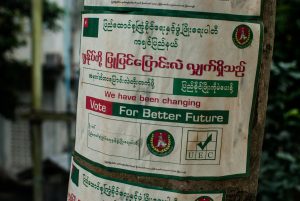Spare a thought, if you have the stomach, for Myanmar’s Union Solidarity and Development Party (USDP).
Ahead of the country’s general election on November 8, the party once again found itself in the unenviable position of having to craft a case against Aung San Suu Kyi, the stupendously popular leader of the National League for Democracy (NLD), who also happens to be the daughter of the martyred anti-colonial hero Aung San.
As if that weren’t enough, the USDP was forced to do so while bearing the taint of association with Myanmar’s military, and its half-century of rule, a dire symphony of privation, conflict, corruption, and human rights violations.
In the event, things went about as well for the USDP as one would expect. According to the official results, the NLD won 396 of the 476 seats up for election in the two houses of parliament. Aung San Suu Kyi’s party even managed to improve on its thundering victory at the last election in 2015.
These figures represent an amazing 83.2 percent of elected seats, a rare figure. This not only ensures that the NLD will form the next government, and that the Aung San Suu Kyi will remain in power as state counselor for a second five-year term; it has also cast doubts over the future of the USDP, which dragged in a puny haul of 33 seats, just 6.9 percent of those up for election. Across the country, senior members of the party, many of them former military commanders, were clobbered, as the NLD made further headway into areas once seen as USDP strongholds.
First contrived by the Myanmar military, or Tatmadaw, to act as its proxy in the 2010 election, the USDP now teeters on the brink of oblivion.
As in 2015, the NLD’s strong showing, and the USDP’s disastrous one, were two sides of the same coin. As Min Zin, executive director of the Institute for Strategy and Policy-Myanmar, wrote in the New York Times this week, the NLD’s success “has less to do with what she stands for than what she stands against: the military’s enduring power, including in civilian affairs.”
After capitulating to the NLD juggernaut, does the USDP have a political future? So far the signs aren’t propitious. The USDP responded to its poor performance by hoisting the banner of fraud, claiming that the election was “unfair” and demanding that the election be rerun with military involvement in order to have “a free, unbiased, and disciplined vote.” This reflex allegation of fraud does not bode well for the party’s ability to change course and cultivate a broader base of support. (At the 2015 election, the USDP’s billboards bore the English-language slogan “we have been changing,” suggesting at least an awareness that it suffers from a grave image problem. But the party will need to do a lot more than craft slogans if it wishes to win back popular support.)
Before the election, the Tatmadaw’s commander-in-chief, Sen. Gen. Min Aung Hlaing had leveled similar claims against Aung San Suu Kyi’s administration, pointing to “weakness and deficiencies” in its management of the election. Since the election, however, the military has distanced itself from the USDP’s claims of fraud – as well it might. As David Hopkins pointed out recently in an article for the Lowy Institute’s Interpreter, the military’s political role is already ring fenced by a constitutional provision granting it 25 percent of seats in each house of parliament – a bloc that amounts to a de facto veto on any constitutional change.
The 2008 Constitution also grants the Tatmadaw control of the country’s three most powerful ministries: defense, border, and home affairs.
Given this constitutional backstop, it is hard to see why the military would go to the mattresses for its proxy party, especially given its dismal performance. Indeed, it’s probable that the military devised the 2008 Constitution in the expectation that the NLD would win any future election that it chose to contest. In this sense, the system is working as intended.
Despite its poor showing, one should cautious about writing the USDP off. Backed by the military’s wealth, and enriched by its lattice of connections to the Tatmadaw’s officer corps, the party has the right ingredients to stage a comeback in 2025. As Hopkins points out, the party’s poor election performance was made to look even worse by Myanmar’s first-past-the-post electoral system, which benefits large parties like the NLD. In the 2015 election, for example, he observes that the USDP won just 8 percent of elected seats, but a relatively healthy 28 percent of the popular vote. (Equivalent figures have not yet been released for the 2020 election.) This suggests that the party has a kernel of support on which it could build.
Then there is the looming question of Aung San Suu Kyi. Now 75 years of age, it is unclear how long the NLD leader will remain in active politics, and equally unclear is how her highly personalized party would adjust to her absence. Once “The Lady” steps aside, a vacuum could open up – if the USDP and its leaders are canny enough to fill it.

































